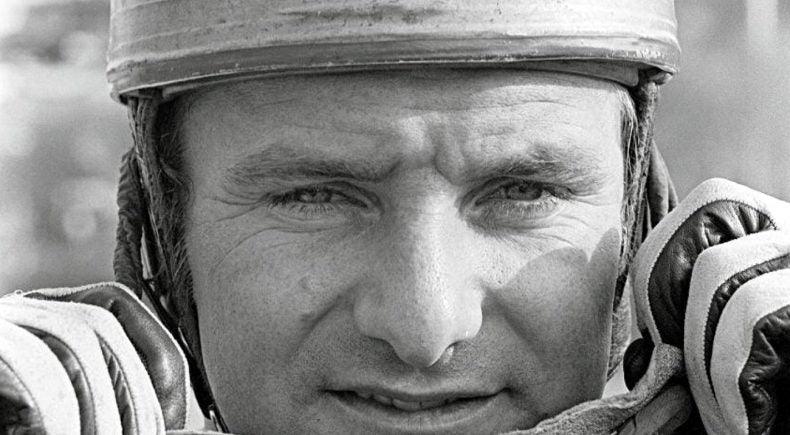
Paul Smart was the racer who launched Ducati’s success in the superbike class with his Imola 200 win in 1972. The funny thing is that when he agreed to do so, the only thing he knew about Ducati was “that they made out-of-date singles [cylinders],” and didn’t know where Imola was. He only knew that that was where the next race was going to be, and that Ducati was offering to pay for his airfare and wages.
Smart was born in 1943 in England and for most of his early racing career wasn’t well known in Europe. He was most successful racing on Japanese bikes for various American teams in the United States, and was considered more of a minor player. His racing career got started when he began racing on small cc bikes in the late 60s in club races after attending the Charles Mortimer Race School. He first earned a name for himself in 1967 when he took second at the Isle of Man TT, and then again in 1969. His first major American race was the 1970 Daytona 200, where he races for Triumph alongside legendary teammates Gary Nixon and Gene Romero.
Until 1972, when Smart’s wife Maggie, sister of fellow racer Barry Sheene, placed a transatlantic phone call to tell him Ducati wanted him to race for them at the inaugural Imola 200 race. At the time, Ducati was not a well-known or respected brand, and their larger-engined motorcycles were not successful in the competitive scene. All Smart knew about them in 1972 was that their single-cylinder motorcycles were underperformers, but was happy to race for them as they would pay both his expenses and wages for the Imola 200.

When he first arrived in Modena, he knew something serious was afoot when he was greeted by a large number of Ducati staff and their head designer Ingenere Fabio Taglioni, who he said reminded him of Triumph’s Doug Hele. Although he said he just wanted to go to bed, they took him straight to the Modena circuit and asked him to do several laps on the new bike so that they could start tuning it specifically to his riding style and preference. By the end of the session, the Ducati mechanics were jumping up and down: he had beaten the revered Agostini’s lap record.
The Imola 200 was meant to draw attention to the Italian race scene, and compete with the American Daytona 200. In 1972, the Imola 200 was called the “200 Miglia,” since it was a 200 mile race (in spite of miles not being a standard unit of measurement in Italy) and was the first race ever dedicated to using only production models. It was anticipated that all manufacturers would want to get involved in the 200 Miglia, since it would be a great marketing tool to say that the exact same bike that won the race could be purchased at your local dealership, but more bikes were prepped in the race pits than racers showed up. Ducati in particular, as did all the other Italian manufacturers, had a difficult time convincing riders to compete on their bikes, which were the first large displacement bikes. Smart couldn’t even convince Sheene, his successful Triumph-racing brother-in-law, to join his team for the 200 Miglia.
But in 1972, on the day of the 200 Miglia, Smart pulled onto the grid astride a Ducati 750 Desmo next to teammate Bruno Spaggiari. In spite of the lower turnout from racers, the event was remarkably well-attended. The track was an old style Grand Prix circuit following the closed-off public roads around the hills of the old town of Imola, and the layout encouraged very high speeds—perfect for the bike he was riding.

In 60s and 70s, bikes weren’t the way they are today in that they would run forever and rarely had technical issues. Parts would often unexpectedly break and end a race for someone.
In the first lap of the 200 Miglia, Agostini’s engine blew up, causing him to lose the lead, and a couple laps after that Smart’s first gear disintegrated. In spite of this, Smart raced ahead and held the lead with teammate Spaggiari.
Ducati was confident that they would win the race, and told Smart and Spaggiari that they were to win the race in first and second place, and hold formation the entire race. This even included a requirement that they refuel together. Which they did, creating enormous tension in the crowd.

In the last lap, Smart recalled hearing the deafening cheers of the audience as he and Spaggiari sped towards the finish line. He had often raced to the screams of British and American audiences, but this was something else, he said.
Smart won the race, and Spaggiari came in second in a dramatic and unexpected victory. Ducati told Smart and Spaggiari that they would split the sum of the winnings for first and second, and they did, sending each home with a sizeable amount of cash. Ducati also promised Smart that if he won, he could keep the bike. In spite of his skepticism, they did give him the bike, which is currently on display at the Ducati musem in Bologna.
With the Imola 200 victory, Ducati was put on the map, and has since created their own rich and storied heritage of racing as they continue to contribute to the greater heritage of motorcycling today.




Leave a comment
All comments are moderated before being published.
This site is protected by hCaptcha and the hCaptcha Privacy Policy and Terms of Service apply.